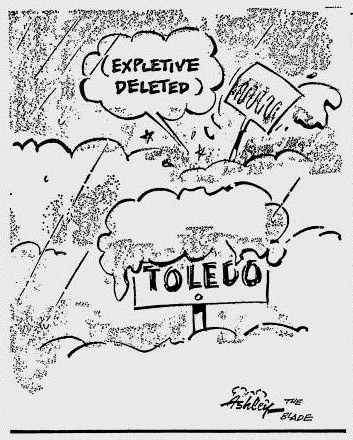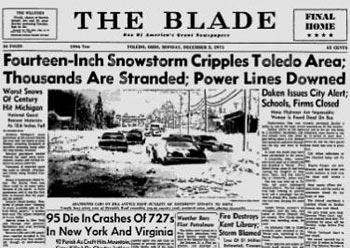My memories of growing up in Toledo frequently revolve around the weather.
The 70s were particularly lively. A cold snap in early 1977 led to a shortage of natural gas, which closed schools. The notorious “Blizzard of ’78” canceled school for about two weeks. So maybe this is all about the school I missed due to the weather.
When a big snowstorm comes along and cripples everything in town – and much of the region – for a few days, it’s something you remember. And that was the case on Sunday, December 1, 1974.
It was memorable for a lot of reasons: it dumped 14 inches of snow on the city, the most I had ever seen up to that point at the ripe old age of eleven; it happened on a Sunday; and it crippled the town good.
And, since it was the Sunday after Thanksgiving, it stopped the travel of everyone passing through town as well. The Red Cross estimated upwards of 12,000 people were stranded and crowded into schools, churches, hotels, motels, and public buildings, including the Sports Arena.
In Sylvania, with two major routes to Michigan running through it, travelers stayed at Central Arena, the roller-skating rink on Holland-Sylvania Road (alas, Central Arena is apparently gone now). The Blade quoted Robert Boehme, Sylvania Township police chief, as saying the situation was one of “wall to wall people.” The Red Cross supplied food, purchased from the Swayne Field Kroger, in approximately thirty locations. One thousand stranded people were at the Red Cross headquarters alone.
There was no going anywhere, eyewitnesses said.
– “I waited for three hours on I-75 at one spot between Bowling Green and Perrysburg, without moving an inch,” Ronald Camp, of Detroit, said. A trip from Dayton to Toledo, which ordinarily took 2-1/2 hours, took eight hours on Sunday.
– Scott Eaton and Mark Slater, both of Pittsburgh, curled up on the lobby floor [of the Commodore Perry Motor Inn downtown] and tried to sleep. Mark’s guitar and a tied bundle of records lay nearby, and no one bothered them. The two were on their way back to Michigan State University, at East Lansing, Mich. “It was stop and go all the way from Cleveland – six miserable hours,” Scott said. “I don’t have the energy enough to move.”

In Perrysburg, refugees piled in to the Dixie Electric Co. nightclub and the nearby Holiday Inn, where more than 1,400 extra guests were housed. Holiday Inn executives were in town to celebrate the hotel’s 120-room French Quarter addition (which had just opened that weekend) and international president John McGuire pitched in to set up beds and supply blankets (In October 2018, the hotel announced it would be closing in 2019 closing after fifty-plus years.)
Meanwhile, at the Sports Arena, the arena’s Exhibit Hall had turned into an impromptu shelter – with an estimated 2,500 people. “The police called us about 9:15 and asked if we could take some people,” Jerry Francis, arena general manager, told the Blade’s Jim Smith. “It wasn’t a half hour before they began coming, and they’ve been coming ever since.” They ate 3,000 hot dogs and drank 500 gallons of coffee and when that ran out, McDonald’s stepped in.
(Personal note: I knew Jim, he was a good guy, worked at The Cincinnati Enquirer for quite a while, and died prematurely. Seeing his byline made me think of him.)
According to Toledo Mayor Harry Kessler, the “snow emergency” he declared was the first in the city’s history. Blade Science Editor Michael Woods estimated it was the third heaviest snowfall in the city’s history, but not even the National Weather Service could pin down the dates: back issues of The Blade reported a snowfall of 22 inches on Feb. 28, 1900, and the next heaviest snow, 16.4 inches, “came sometime between 1900 and Sunday” according to the NWS.
There weren’t many injuries or other disasters, save two: a woman was found dead on a Greyhound bus stranded in Toledo, and a fire gutted the Kent branch of the Toledo-Lucas County Public Library which underwent an extensive renovation completed in 2011.
Interesting links
An informative site about Toledo snowstorms, which does a really thorough job of listing them all.


I remember that I was 10 yrs. Old
I lived in the south end
Loved the memories, I was surprised while reading this how clear it all is.
Toledo growing up in the 60’s and 70’s, what beautiful stomping grounds
Stomping grounds because we stomped all over the neighborhoods.
If we didn’t go to school with someone in a home, one of our siblings did!
I charish growing up there in those years. Bless you all
The Blizzard of 1974 sticks in my memories. I was a Senior at Waite High School. One of the closings of Toledo Schools in my 13 years of attending. First time was a Blizzard on November 1, 1966. My Paternal Grandfather had died. My Dad & I were shoveling the snow so he could get to work as a Toledo Fire Fighter. My Car a 1960 Lincoln Continental Mark V was covered in snow to the roof. We got it cleared of snow & I was trying to get it free. The ice under the snow caused the car to go side ways on Price St. Got it stuck real good. Dad reprimanded me for not following his instruction. I got out of the car & left for a long exhausting walk.
Elizabeth Ann Skinner was born on December 1, 1974, the neighbor kids helped shovel the walk so mom Connie could get to the Ford truck, Connie’s Toyota Corolla was buried, dad Mike drove the truck up Gasser street to flower hospital where Elizabeth was born . Sorry to say the doctor didn’t make it, so one of the stranded staff doctors delivered her, a healthy beautiful baby girl. A memory never to forget. Today Elizabeth and her husband George are serving as Jehovah’s Witness missionaries in Tanzania East Africa.
The snowstorm is one of three sad and troubling memories I remember from 1974. I had just graduated from SUA and was so happy to start college at UT and then turn 18 years old. The first adult thing I did was sign consent for emergency surgery on 10-25-74. I was finally feeling almost normal when the 12-1-74 snowstorm hit and buried Toledo. Then my two youngest sisters witnessed the car v pedestrian death of their 12 year old dear friend, and we attended her closed casket funeral 12-24-74. That was a end of the childhood for me and the children of our neighborhood.